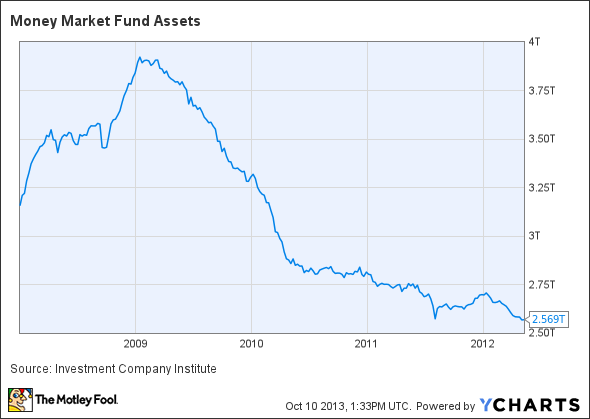4 Types Of Money Market Yields Yahoo Singapore Finance
Post on: 30 Март, 2015 No Comment

Short-term debt markets have a direct effect on borrowing and lending, which affects investment analysis as well. Through the discounting of potential investments, the money market can help determine alternative returns and thus compare an investor’s options.
Debt markets have various ways of presenting and calculating the yield on your investment. Determining the yield seems straight forward when you think about normal investments, but in debt instruments the yield can sometimes get a little complicated. Take Treasury bills (T-Bills) for instance, the U.S. issues debt to investors and sets a specific amount that will be paid at maturity. This is called the face value. To determine the return, you need to look at the cost to purchase this. The difference between the cost and the face value is called the discount. But, to make things a little more complicated the length of time is not a year — it could be a couple of days, or a couple of months. Different types of yields use different conventions in converting this time period into a year. So, you will need to compare the face value to the amount promised to be paid back and convert the time period to a one year yield.
There are four main types of yields that will be covered, which will help you navigate the different ways returns are presented: the bank discount yield (also called bank discount basis), holding period yield, effective annual yield and the money market yield.
Bank Discount Basis
T-Bills are quoted on a pure discount basis, which means the agreement states the total money that will be paid at maturity, and the investor pays a lower amount. The difference between these two numbers (the discount) is the return, but to get a yield it still needs to be converted to a yearly percentage.
In this situation, the formula for calculating the yield is simply the discount, divided by the face value, multiplied by 360 and then divided by the amount of days remaining to maturity.
Annualized yield on a bank discount basis =
3a%2f%2fglobalfinance.zenfs.com%2fen_us%2fFinance%2fUS_AFTP_INVESTOPEDIA_H_LIVE%2fbank-discount-basis.gif&t=1426316767&sig=n0ET8XU3cIUi4SLbDtd89Q—
Where:
D = Discount
F = Face value
T = Number of days until maturity
For example, Joe purchases a T-Bill with a face value of $100,000 and pays $97,000 for it. The maturity date is in 279 days. What is the bank discount yield?
Bank discount yield = (D/F) x (360/t)
= (3,000/100,000) x (360/279)
= 0.0387
But, there are a couple of problems with using this annualized yield in determining your return. For example, this yield uses a 360-day year to calculate the return an investor would receive. Also, it does not take into account the potential for compounded returns, and only assumes you have no other investment options.
The remaining three popular yield calculations give a better representation of an investor’s return.
Holding Period Yield
The holding period yield by definition is only calculated on a holding period basis. So there is no need to include the number of days, which was included in the bank discount yield. It seems pretty straight forward, that you take the increase in value from what you paid, add on any interest or dividend payments and divide it by how much you purchased it for. This is the unannualized return, which is different than most return calculations that like to show returns on a yearly basis. Also, the interest or cash disbursement paid, is assumed to happen at the time of maturity.














